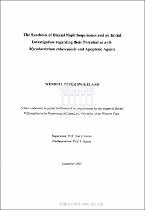| dc.contributor.advisor | Green, Ivan R. | |
| dc.contributor.author | Swigelaar, Wendell Peter | |
| dc.date.accessioned | 2022-11-02T11:07:17Z | |
| dc.date.available | 2022-11-02T11:07:17Z | |
| dc.date.issued | 2009 | |
| dc.identifier.uri | http://hdl.handle.net/11394/9403 | |
| dc.description | Philosophiae Doctor - PhD | en_US |
| dc.description.abstract | Tuberculosis and cancer are amongst the most devastating diseases affecting the world today, especially Africa and other less developed countries. Both diseases have the ability to develop resistance against drugs being used as treatment regimes and therefore the search for effective novel drugs remains an ongoing challenge. Diospyrin and its monomer 7-methyljuglone, both naturally occurring quinones, and
their synthetic derivatives have been shown to exhibit significant antimycobacterial and anti-tumour activity. The present study focuses on the synthesis of new compounds of similar structures to that of the lead compounds diospyrin and 7-methyljuglone, and their evaluation as potential antimycobacterial and anti-cancer agents via apoptosis. Three methoxynaphthoquinones were synthesized and coupled to several
commercially available boronic acids using the Suzuki methodology. Eight compounds were evaluated against a drug susceptible strain, H37Rv of Mycobacterium tuberculosis, using the BACTEC method. Results indicate that the presence of an hydroxyl group peri to the quinone carbonyl moiety is crucial for these quinonoidal compounds to be effective as anti-TB agents, since their methyl ether analogues had little effect on the growth rate of the bacteria. Substituents, capable of donating electrons through a resonance electron effect to the carbonyl group, peri to the methoxy group, also enhance activity of these molecules. Several of the synthesized compounds were screened for their ability to induce apoptosis in five human cancer cell lines viz.,Hl57,Hek239T, HeLa, Jurkat, MCF-7 and two non cancerous cell lines viz., CHO (animal) and KMST-6 (human). The methods employed to assess the pro-apoptotic potential of the compounds were
APOPercentagerM and DNA fragmentation. The APOPercentagerM assay showed that the activity of the compounds is concentration dependent and also revealed that in addition to the redox ability of the quinone carbonyl groups, the peri methoxy or hydroxyl group also plays a role in the apoptotic activity. An independent evaluation, the DNA fragmentation test, confirmed both a degree of selectivity viz, being not too active against non-cancerous cell lines on the one hand whereas on the other having a high apoptotic potential against all five of the cancer cell lines evaluated. | en_US |
| dc.language.iso | en | en_US |
| dc.publisher | University of the Western Cape | en_US |
| dc.subject | Cerium (IV) ammonium nitrate | en_US |
| dc.subject | Deoxyribonucleic acid (DNA) | en_US |
| dc.subject | Death Effector Domain (DED) | en_US |
| dc.subject | Cerium (IV) ammonium nitrate (CAN) | en_US |
| dc.subject | Ehrlich Ascites Carcinoma (EAC) | en_US |
| dc.subject | Ethambutol (EMB) | en_US |
| dc.subject | Dimethylformamide (DMF) | en_US |
| dc.subject | Human Immunodeficiency Virus (HIV) | en_US |
| dc.title | The Synthesis of Biaxial Naphthoquinones and an Initial Investigation regarding their Potential as anti- Mycobacterium tuberculosis and Apoptotic Agents | en_US |
| dc.rights.holder | University of the Western Cape | en_US |

